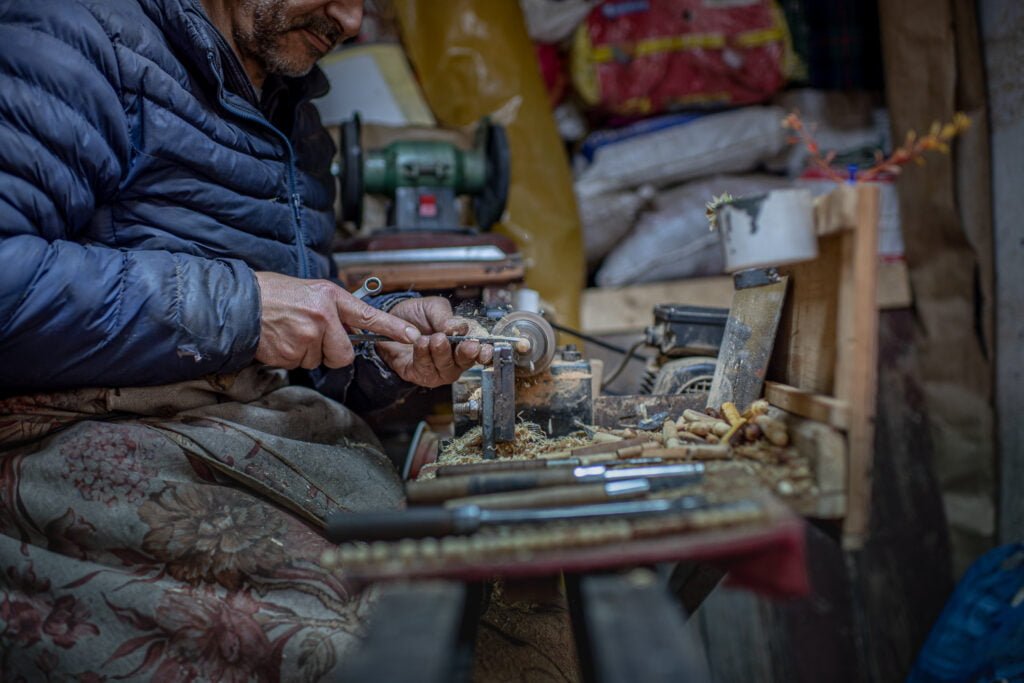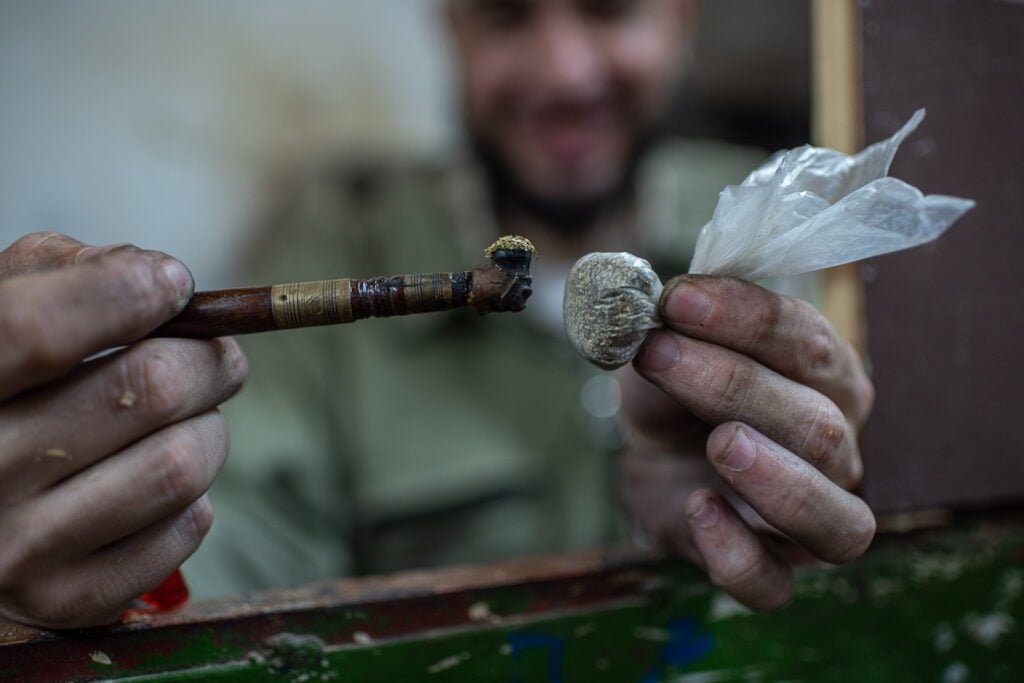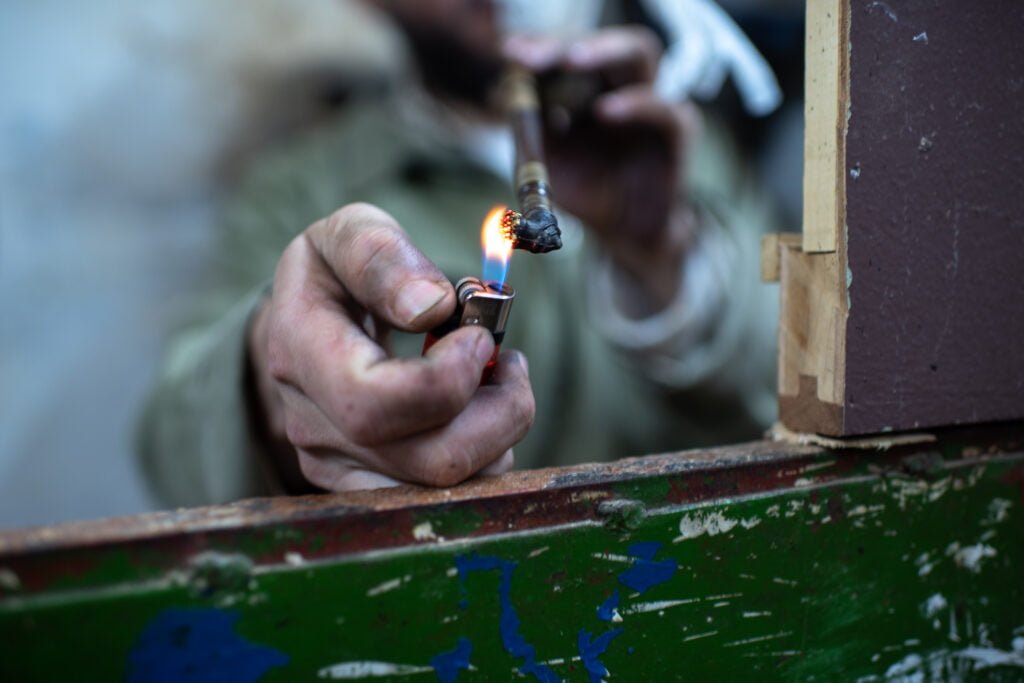The green medina of Ouezzane contains an area of small workshops where artisans produce a range of products for the consumption of mostly local inhabitants.
Around this artisanal area the haunting tapping of hammers, low drone of power tools and the general pallor of endeavour permeates the narrow lanes and alleyways.
One of the most popular trades is the making of the sebsi, that is a pipe for smoking marijuana known in Morocco as kif.

Going to any downtown cafe throughout Morocco it is common to find men lighting up the green organic contents of small wooden or metal bowls attached to long slender wooden stems. The wooden stems are sucked avidly until the initial bright spark of ignition changes to a moderate glow and a long swirl of smoke curls into the air. Hidden under the hoods of djellabas and whilst playing cards and drinking tea, men partake in an ancient past-time of intoxication in a country where alcohol is mostly forbidden and marajuana widely available.

It has been estimated that Morocco produces up to half the marijuana used across the world, and certainly most of that used in Europe. It is grown predominantly in the north of Morocco, in the Rif mountains, where huge swathes of land is given over to its production. Any visitor to Chefchaouen can walk up the steep mountainside behind the town and within minutes be amongst the beginning of plantations which extend north, east and west for many miles. It is even possible to hire guides from the town to give tours of the fields. One of the poorest areas in Morocco, local farmers continue to grow crops in order to earn an income. Plantations can range from small individual farms to collectives cultivating huge areas in organised and sometimes criminal syndicates.

Smoking kif in Morocco is officially illegal. A change of law in 2021 has permitted the growth of marijuana for medicinal, cosmetic and industrial purposes; though recreational use is still officially outlawed. This change in law does provide legitimate cover for cannabis to be grown, and it remains one of the most profitable industries in Morocco as well as one of its most valuable exports. Although recreational use is illegal, in practice many Morrocan towns and cities are considered to be tolerant of its use, though it is suggested that police informers often act as dealers and have an informal understanding of consumption and illegal distribution routes. Penalties for illegal consumption vary and can be up to 10 year in prison.

Morocco, before and following the hippy trails of the 1960s, has been been popular with marijuana-using visitors. Early imbibers were primarily the Beat era authors and artists who flocked to Morocco in the days of the International Zone prior to Morocco’s independence on March 2nd 1956. On cliffs overlooking both the Atlantic Ocean and the distant coastline of Spain, the same writers, musicians and artists imbibed Moroccan tea infused with kif on the long terraces of Cafe Hafa. It was regarded as a house specialty. Even now, in Tangier’s Cafe Baba photographs of kif smoking Keith Richards from the Rolling Stones remain next to a photograph of Khofi Annan, the former Secretary General of the United Nations. The passing of time diffuses many boundaries.
Another use of kif was as a constituent of the drug majoun. Kif was mixed with honey, nuts, spices and other substances, including sometimes opium, before being rolled into balls and cooked for later consumption. This was a favourite of the Beat authors and artists, who found its hallucinatory properties to their taste.
One of those authors, the American Paul Bowles who lived in Tangier for 52 years until his death, graphically describes in his novel Let It Come Down the devestating effect of taking cannabis/majoun by an American ex-pat living in Tangier, especially its role in it’s principle character Nelson Dyar’s murder of another.

The role of marijuana in spiritual pursuits is far less clear. It has been suggested that ‘The history of cannabis in predominantly Islamic societies was closely linked to the history of some Sufi movements, which led to cannabis being referred to as the “Sufi herb”. Some Sufis even included the consumption of cannabis in their rituals. Cannabis helped them to either relax or go into a trance. There was even one Sufi who referred to hashish as the “morsel of meditation”. ‘
The same source states this potential use conflicts with restrictions introduced many centuries ago ‘For the majority of legal scholars, the consumption of cannabis is haram ( forbidden ). From the thirteenth century onwards, theologians adopted an increasingly strict stance. This reflected the mass phenomenon of cannabis consumption in many Muslim countries at the time, especially among the Mamluks and the Ottomans. Most treatises opposing the consumption of cannabis therefore tend to date from this era….. The legal scholars opposed to the consumption of cannabis refer to an Islamic legal maxim that states that everything that is intoxicating in large amounts may not be consumed in small amounts’.
This source provides more information regarding the potential benefits of cannabis use for spiritual exploration ‘The benefits they claimed from their use of hashish included otherwise unattainable insights into themselves, as well as laughter, happiness, reduced anxiety, reduced worry, and increased music appreciation. But most importantly, as the Sufi al-Is’irdi noted, was the “secret” of the drug, which permits “the spirit to ascend to the highest points in a heavenly ascension of disembodied understanding.” ‘

The final photograph below shows an electric guitar and a djembi drum on the walls of a sebsi workshop. Both are covered in sawdust. I thought this was an interesting image.
